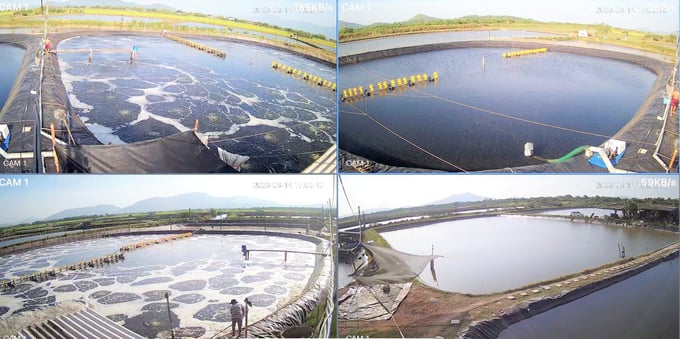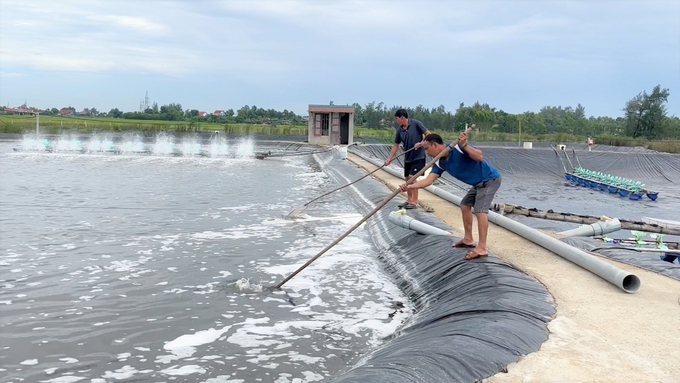May 31, 2025 | 06:54 GMT +7
May 31, 2025 | 06:54 GMT +7
Hotline: 0913.378.918
May 31, 2025 | 06:54 GMT +7
Hotline: 0913.378.918

In 2023, disease outbreaks on shrimp have decreased by 44% compared to 2022. Photo: Thanh Nga.
Implementing the project to restructure the agricultural sector from 2021 to 2025, with a vision to 2030, Ha Tinh province determined that shrimp is both a key farming object and an object with advantages in commodity-oriented development.
However, to bring shrimp farming to sustainable development, two factors that need to ensure absolute safety are disease and the environment.
There were times when people in coastal areas, such as Nghi Xuan, Thach Ha, and Cam Xuyen, rushed to raise shrimp on the sand. Many farms invested VND 3 - 4 billion, even tens of billions of VND, but only successfully raised the first 1 - 2 crops, then epidemics surrounded them, leading to failure and abandonment of ponds and lakes.
The reason is partly due to weather, climate, and soil, but the main thing is still farmers' lack of expertise and awareness in environmental protection and disease prevention.
In the past 5 years, shrimp farming technology has developed daily, allowing people to shift from extensive and improved shrimp farming to intensive and high-tech farming.
This is one of the prerequisite solutions, contributing to minimizing water pollution and dangerous infectious diseases such as white spot, acute hepatopancreatic necrosis, microsporidia...

Regular monitoring of water sources in farming areas has provided early warning, creating proactiveness for people in preventing shrimp diseases. Photo: Thanh Nga.
Mrs. Dang Thi Thu Hoan, Deputy Director of the Department of Animal Husbandry and Veterinary Medicine of Ha Tinh province, informed that in 2023, the whole province had raised 2,239 hectares of shrimp but only 50 hectares will be infected with white spot diseases (more than 41 hectares); acute hepatopancreatic necrosis (3.6 hectares) and microsporidia (nearly 5 hectares); down 44% compared to 2022.
Diseased areas are concentrated in Ky Anh, Cam Xuyen, Thach Ha, Loc Ha, Nghi Xuan districts, Ky Anh town, and Ha Tinh City.
"Many factors affect the effectiveness of disease prevention in shrimp. However, people's proactive investment in farming area infrastructure and specialized agencies' timely monitoring, warning, and handling of narrow-area outbreaks are the main solutions, contributing to minimizing damage caused by diseases harm to farmers," Ms. Hoan said.
On May 4, 2023, a white spot disease outbreak occurred in the shrimp farming area of 13 households in Bac Son Hai village, Bac Hai, Ky Hai commune, Ky Anh district, killing 830,000 shrimp on an area of nearly 9 hectares.
Immediately after determining that the shrimp sample was positive for the virus that causes white spot disease, the Center for Application of Science, Technology and Protection of Plants and Animals of Ky Anh district coordinated with the Provincial Department of Livestock and Veterinary Medicine to quickly guide standards. Destroy diseased ponds.
At the same time, the locality also synchronously deployed epidemic prevention solutions such as supporting 1,500kg of chlorine chemicals to surround the outbreak, cleaning and disinfecting tools for shrimp farming, and thoroughly treating all types of disease-causing intermediate parasites...

Investing in converting from extensive shrimp farming to intensive, high-tech farming creates a favorable environment for shrimp to grow and limits dangerous infectious diseases from arising. Photo: Thanh Nga.
“Thanks to timely control of the white spot epidemic in the spring-summer crop and ensuring pond renovation, the recent fall-winter shrimp farming season, all 9/9 hectares of Ky Hai commune people won. Some households earn billions of VND in profit," Ky Hai commune leader said.
Previously, high-tech intensive shrimp farming was only applied in sand-based farming areas with favorable conditions, such as Cam Xuyen and Nghi Xuan districts... currently, in earthen pond farming areas, farmers lagoon in Mai Phu commune, Ho Do (Loc Ha district); Ky Ha and Ky Thu communes (Ky Anh district)... have also boldly applied and deployed new technologies.
Ms. Nguyen Thi Hoai Thuy, Head of Aquaculture Department (Ha Tinh Fisheries Sub-Department), said that upgrading infrastructure and investing in technology in intensive shrimp and high-tech intensive farming is the trend. It will solve environmental problems and diseases, adapt to climate change, and improve productivity and economic efficiency for farmers.

Although shrimp prices are pretty low, most people still earn high profits from farming ponds this year. Photo: Thanh Nga.
Currently, there are many organizations and individuals in Ha Tinh area investing in intensive shrimp farming in tidal flat earthen ponds, high-tech farming on sand, achieving productivity of 10 - 15 tons/ha/crop in earthen ponds and 20-30 tons/ha/crop in earthen ponds, and 30 tons/ha/crop in high-tech ponds on the sand.
Others improve ponds and lakes by spreading tarpaulin; bank flapping - covering the bank with stone powder, aerating the bottom; raised in closed houses or net houses; 2 - 3 stages of farming; Building and replicating intensive shrimp farming models in the direction of VietGAP... contributing to increasing the total area of intensive shrimp farming, high technology, and production in the form of cooperation and association throughout the province to 629 hectares.
Translated by Tuan Huy

(VAN) Several scientists and farmers are experimenting with soil treatment in some key durian-growing regions such as Cai Lay (Tien Giang), Dak Song, Gia Nghia, and Dak R’lap (Dak Nong).
/2025/05/25/4127-3-073637_820.jpg)
(VAN) Thanks to the promotion from an FAO-implemented project, vegetable production in greenhouses in Moc Chau has seen strong development, from 1.5 hectares in 2021 to nearly 50 hectares in 2024.

(VAN) FAO has recently supported USD 140,000 to implement the project 'Risk mitigation human-animal interface risks through disease control initiatives in pig farming.'

(VAN) The People's Committee of Tra Vinh province has approved an adjustment to the investment policy for the Green Hydrogen Plant project, increasing its area to approximately 52.76 hectares.
![Reducing emissions from rice fields: [2] Farmers’ commitment to the soil](https://t.ex-cdn.com/nongnghiepmoitruong.vn/608w/files/news/2025/05/05/dsc08881jpg-nongnghiep-140632.jpg)
(VAN) Clean rice cultivation model in Thuong Tan commune, Bac Tan Uyen district, is assisting local residents in achieving sustainable agriculture by substantially reducing costs, increasing productivity, and protecting the environment.

(VAN) At the conference to disseminate Resolution No. 68, AgriS introduced its digital agricultural ecosystem and reaffirmed its commitment to accompanying the Government in promoting private sector development and sustainable agriculture.

(VAN) 'Blue Ocean - Blue Foods' initiative is designed to restore marine ecosystems and establish sustainable livelihoods for local communities by cultivating a minimum of 1,000 hectares of cottonii seaweed in the first three years.